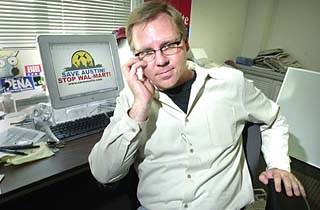Here a Box, There a Box, Everywhere a Big Box
One Lowe's, two Wal-Marts, and three sets of angry Southside citizens
By Amy Smith, Fri., Aug. 22, 2003

"In order to preserve the quality of life our community is accustomed to, it is important to change with the times." So says Wal-Mart in a colorful mailer sent to thousands of South Austin households last week. "That means," the discount retailer cheerfully informs us, "updating zoning to reflect the needs of a growing community."
And who better than Wal-Mart to tell South Austinites what's best for South Austin? The retailer's latest PR target is the Park Ridge Homeowners Association, Wal-Mart's potential neighbors and opponents of the company's plan to put a 203,622-square-foot Supercenter on the southwest corner of I-35 and Slaughter Lane. "We're not against everything," said HOA President Aron Wisneski, "we're against the biggest thing. And unless the military decides to build a weaponry plant at I-35 and Slaughter, a super-Wal-Mart is the biggest thing."
This particular dispute is the least publicized of the three big-box battles currently playing out south of Ben White. More energy has gone into trying to prevent two super-stores from being built on top of the increasingly endangered Edwards Aquifer -- another proposed Wal-Mart Supercenter at MoPac and Slaughter and a Lowe's Home Improvement Warehouse on Brodie Lane in Sunset Valley -- than it has to a proposed development in the preferred growth corridor along I-35.
But then, the image-plagued Wal-Mart isn't exactly a community favorite in the U.S. these days. For its proposed I-35 store, Wal-Mart needs a zoning change and hopes the pricey mailers will serve as a pre-emptive strike against the crowd of opponents that's expected to turn out at the Tuesday, Aug. 26, Zoning and Platting Commission meeting. The ZAP delayed action on the item earlier this month at the request of the Park Ridge neighbors. HOA President Wisneski cites increased traffic, reduced property values, and crime associated with large shopping areas as the primary reasons for opposing the project.

Meanwhile, five miles to the west, the No Aquifer Big Box coalition has retained attorney Jeff Frazier, one of the lawyers in the Tulia drug case, to perform a legal analysis of a previous city agreement on the MoPac/Slaughter property, granting the zoning that Wal-Mart and landowner Endeavor Real Estate Group (which also controls the I-35/Slaughter property) want. Frazier declined to comment on specifics until he's had a chance to study the agreement. In other anti-Wal-Mart hirings, former Will Wynn aide Mark Nathan and his recently formed Archer Nathan consulting firm have been retained by the Circle C Homeowners Association to help the opposition. This particular HOA seldom meets a development it doesn't like, but a 24-hour Wal-Mart is something else again -- and a cause on which both left and right can agree.
In the Lowe's case, resistance ramped up anew last week after the Save Our Springs Alliance obtained, through an open-records request, a sheaf of illuminating correspondence between the city's outside counsel Casey Dobson and Lowe's reps Terry Irion, an Austin development lawyer, and Bruce Todd, former-mayor-turned-lobbyist. The most shocking revelation was Dobson's willingness to start negotiations at 40% impervious cover -- the same amount that Lowe's asked for in the first place, when the property was under Sunset Valley's jurisdiction. Sunset Valley tried to circumvent the project by ceding control of the property to the city of Austin, with the idea that the city would enforce the 15% impervious cover limit under the SOS Ordinance. A lawsuit and a legislative maneuver on Lowe's behalf complicated matters, however, forcing both sides to the negotiation table.
SOS leaders have frequently criticized the way Dobson cuts development deals on the city's behalf (he brokered last year's controversial deal with Stratus Properties), and they point to the Lowe's proposal as another example of lackluster advocacy. "The documents show that [Dobson], at great taxpayers' expense, from the beginning of his negotiations did not even try to obtain SOS compliance or prevent a big-box development on this site," said SOS lawyer and Deputy Director Brad Rockwell. "How many hundreds of thousands of dollars has the city paid Dobson and his law firm to capitulate to developers?" On the bright side, Rockwell pointed out that several council members have already gone on record opposing big-box developments over the aquifer.
For his part, Dobson said 40% was what Lowe's originally proposed in accordance with Sunset Valley's regulations, but that House Bill 1204 changed the playing field by putting the development under the county's nonexistent water regulations. "If [Lowe's] is right about what HB 1204 means, then there are no water-quality rules," Dobson said. "Our focus is to try to get them to agree to SOS water-quality controls. The most important thing is to try to prevent degradation of the aquifer." In that respect, he added, "we've come a long way compared to what was proposed and what is on the table now."
But the agreement is nowhere near closure, Dobson added, and is still at least a month away from going to council for a vote -- "if it ever comes to that." He said he has laid out various scenarios in executive session of what could happen if the deal falls through. One giant hurdle centers on how Lowe's will fulfill mitigation responsibilities, which could include forking over money for property acquisition and conservation. "That's a major unresolved issue in negotiations," Dobson noted, "but that's not to say there aren't others."
Rockwell, on the other hand, argues that Austin is in a strong negotiating position to enforce SOS in this instance. Lowe's, for example, is requesting water and wastewater services from Austin. Environmentalists view that as a leverage-booster for the city, despite Irion's comments to the contrary. In a July 23 letter to Dobson, Irion noted that if Lowe's is refused water and wastewater service from either the city or Sunset Valley, the development would rely on two grandfathered wells on the property to draw an estimated 5,000 gallons of water per day from the aquifer. And if those aren't sufficient to produce the amount of water Lowe's needs, Irion pointed out, Lowe's could simply drill another well.
Got something to say on the subject? Send a letter to the editor.








